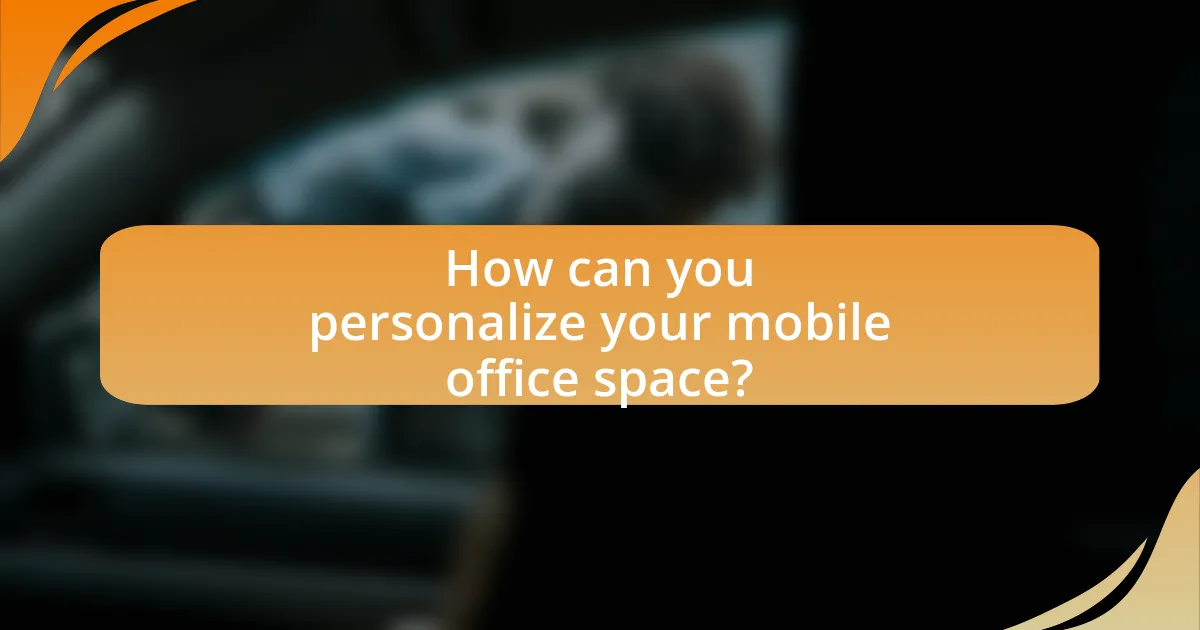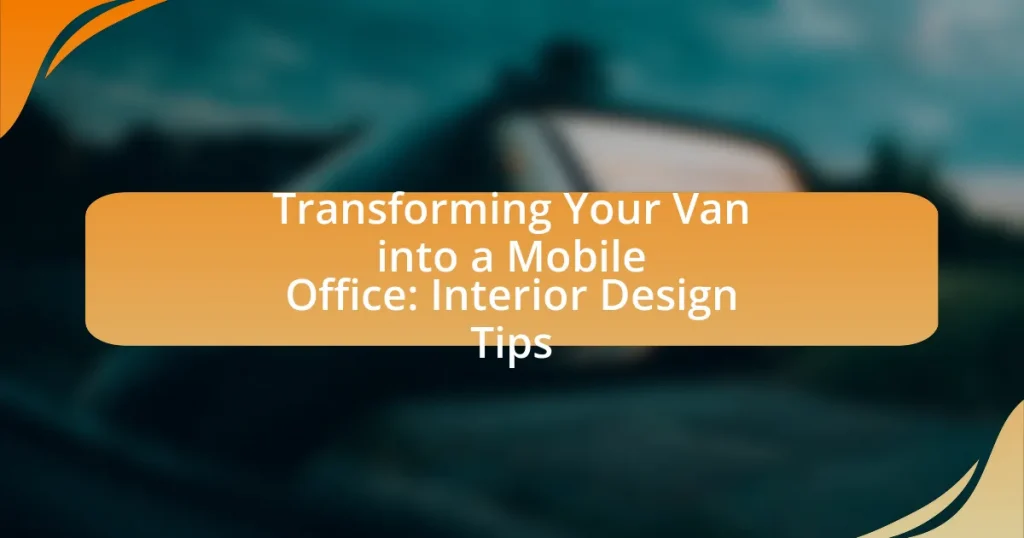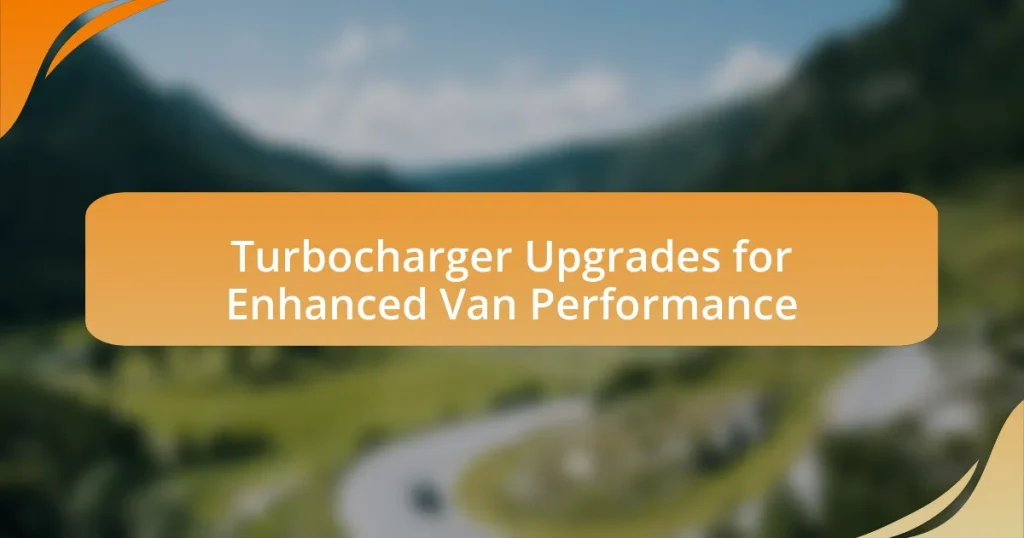Transforming a van into a mobile office involves converting the vehicle into a functional workspace equipped with essential office tools such as desks, ergonomic seating, and power sources. This article explores how a mobile office can enhance productivity through flexibility and reduced commuting time, while also detailing key features necessary for effective design, such as space optimization and ergonomic considerations. Additionally, it addresses practical tips for maximizing storage, maintaining comfort, and personalizing the workspace, alongside solutions for connectivity and climate control. The insights provided aim to assist individuals in creating a productive and efficient mobile work environment.

What does it mean to transform your van into a mobile office?
Transforming your van into a mobile office means converting the vehicle into a functional workspace that allows for productivity while on the move. This process typically involves outfitting the van with essential office equipment such as a desk, ergonomic seating, power sources, and storage solutions to facilitate work tasks. The concept is supported by the growing trend of remote work, where individuals seek flexible environments that enhance their work-life balance, allowing them to work from various locations without sacrificing comfort or efficiency.
How can a mobile office enhance productivity?
A mobile office enhances productivity by providing a flexible workspace that allows individuals to work from various locations. This flexibility reduces commuting time and enables workers to choose environments that boost their focus and creativity. Studies show that remote work can increase productivity by 13% due to fewer distractions and a more comfortable work setting. Additionally, mobile offices can be equipped with technology that facilitates communication and collaboration, further improving efficiency.
What are the key features of an effective mobile office?
An effective mobile office includes portability, connectivity, and functionality. Portability ensures that the office can be easily moved and set up in various locations, which is essential for a mobile environment. Connectivity is crucial, as reliable internet access allows for seamless communication and access to necessary resources. Functionality encompasses the design and layout of the workspace, ensuring it is equipped with essential tools such as a desk, comfortable seating, and adequate storage. These features collectively enhance productivity and comfort while working remotely.
How does a mobile office differ from a traditional office setup?
A mobile office differs from a traditional office setup primarily in its flexibility and location. Mobile offices are designed to be portable, allowing individuals to work from various locations, such as a van or other vehicles, while traditional offices are fixed spaces that require employees to commute to a specific location. This mobility enables users to adapt their work environment to different settings, enhancing productivity and work-life balance. According to a study by Global Workplace Analytics, remote work can increase productivity by 13%, highlighting the effectiveness of mobile office setups compared to conventional office environments.
What are the essential considerations for designing a mobile office?
The essential considerations for designing a mobile office include space optimization, ergonomic furniture, power supply, connectivity, and storage solutions. Space optimization ensures that every square foot is utilized effectively, allowing for a functional work environment. Ergonomic furniture, such as adjustable desks and supportive chairs, promotes comfort and productivity during long working hours. A reliable power supply, including solar panels or portable generators, is crucial for operating electronic devices. Connectivity through mobile hotspots or satellite internet is necessary for seamless communication and access to online resources. Finally, adequate storage solutions, like cabinets and organizers, help maintain a clutter-free workspace, enhancing focus and efficiency.
How do space limitations affect design choices?
Space limitations significantly influence design choices by necessitating efficient use of available area. Designers must prioritize functionality and adaptability, often opting for multi-purpose furniture and compact layouts to maximize utility within confined spaces. For instance, in a mobile office setting, a foldable desk can serve as both a workspace and a dining area, illustrating how space constraints drive innovative solutions. Additionally, the need for storage solutions becomes critical; built-in cabinets and under-seat storage are common strategies to keep the area organized while maintaining accessibility. These design adaptations are essential for creating a comfortable and practical environment in a limited space.
What role does ergonomics play in mobile office design?
Ergonomics plays a crucial role in mobile office design by ensuring that workspaces are comfortable, efficient, and conducive to productivity. Proper ergonomic design minimizes physical strain and discomfort, which can lead to improved focus and reduced fatigue during work hours. For instance, adjustable seating and desk heights can accommodate various body types, promoting better posture and reducing the risk of musculoskeletal disorders. Research indicates that ergonomic interventions can enhance productivity by up to 25%, demonstrating the significant impact of ergonomics on work performance in mobile environments.

What interior design tips can help optimize your van for work?
To optimize your van for work, prioritize multifunctional furniture and efficient storage solutions. Utilizing foldable desks and chairs can maximize space while providing necessary work surfaces. Incorporating built-in storage compartments helps keep the area organized and reduces clutter, which is essential for maintaining focus. Additionally, using light colors for walls and furnishings can enhance natural light, creating a more inviting and productive atmosphere. Research indicates that well-organized workspaces can improve productivity by up to 20%, highlighting the importance of effective interior design in mobile work environments.
How can you maximize storage in a mobile office?
To maximize storage in a mobile office, utilize multifunctional furniture and vertical space. Multifunctional furniture, such as a desk that doubles as storage or seating with built-in compartments, optimizes limited space effectively. Additionally, installing shelves and cabinets that reach up to the ceiling allows for the use of vertical space, which is often underutilized in mobile environments. According to a study by the American Institute of Architects, efficient use of vertical storage can increase usable space by up to 30%, demonstrating the effectiveness of these strategies in enhancing storage capacity in compact areas.
What types of storage solutions are best for small spaces?
The best types of storage solutions for small spaces include multifunctional furniture, vertical storage, and modular shelving. Multifunctional furniture, such as ottomans with storage or beds with drawers, maximizes utility while minimizing space usage. Vertical storage solutions, like wall-mounted shelves and hooks, utilize vertical space effectively, allowing for more floor area. Modular shelving systems can be customized to fit specific dimensions and needs, providing flexibility in organization. These solutions are particularly effective in small environments, as they optimize available space and enhance functionality.
How can multifunctional furniture enhance usability?
Multifunctional furniture enhances usability by maximizing space efficiency and providing versatile solutions for various needs. In a mobile office setting, such as a van, furniture that serves multiple purposes—like a foldable desk that can also function as storage—allows for a more organized and flexible environment. This adaptability is crucial in limited spaces, enabling users to easily transition between work and leisure activities without clutter. Studies indicate that well-designed multifunctional furniture can improve productivity by up to 30% in small workspaces, demonstrating its effectiveness in enhancing usability.
What are the best practices for creating a comfortable work environment?
The best practices for creating a comfortable work environment include optimizing space, ensuring ergonomic furniture, and maintaining proper lighting. Optimizing space involves decluttering and organizing the area to enhance productivity and comfort. Ergonomic furniture, such as adjustable chairs and desks, supports physical well-being and reduces strain during long working hours. Proper lighting, particularly natural light, improves mood and focus, contributing to a more pleasant atmosphere. Research indicates that well-designed workspaces can increase employee satisfaction and productivity by up to 20%.
How can lighting impact your workspace in a van?
Lighting significantly impacts your workspace in a van by influencing visibility, mood, and productivity. Adequate lighting enhances visibility, allowing for detailed tasks such as reading or working on a computer without straining the eyes. Studies show that natural light can improve mood and energy levels, which is crucial in a confined space like a van. Furthermore, the right lighting can create a comfortable atmosphere, reducing stress and increasing focus. For instance, a study published in the Journal of Environmental Psychology found that well-lit environments can enhance cognitive performance and overall satisfaction in work settings. Thus, effective lighting design is essential for optimizing a mobile office in a van.
What materials are recommended for a mobile office interior?
Recommended materials for a mobile office interior include lightweight plywood, durable laminate, and sound-absorbing fabrics. Lightweight plywood is favored for its strength-to-weight ratio, making it ideal for constructing furniture and storage solutions without adding excessive weight to the vehicle. Durable laminate surfaces are recommended for countertops and workspaces due to their resistance to scratches and easy maintenance. Sound-absorbing fabrics are beneficial for upholstery and wall coverings, as they help reduce noise and create a more comfortable working environment. These materials collectively enhance functionality and comfort in a mobile office setting.

How can you personalize your mobile office space?
To personalize your mobile office space, incorporate elements that reflect your personal style and enhance functionality. This can include selecting a color scheme that resonates with you, adding decorative items like plants or artwork, and utilizing ergonomic furniture that suits your work habits. Research indicates that personalized workspaces can increase productivity and job satisfaction, as individuals feel more comfortable and motivated in environments that reflect their identity.
What design elements can reflect your personal style?
Design elements that can reflect personal style include color schemes, furniture choices, materials, and decorative accents. For instance, a vibrant color palette can convey energy and creativity, while neutral tones may suggest calmness and professionalism. The selection of furniture, such as minimalist desks or vintage chairs, can showcase individual preferences and functionality. Additionally, materials like wood, metal, or fabric can express personal taste; for example, reclaimed wood can indicate a preference for sustainability. Decorative accents, such as artwork or plants, further personalize the space, allowing for unique expression. These elements collectively create an environment that resonates with the individual’s identity and lifestyle.
How can color choices influence mood and productivity?
Color choices significantly influence mood and productivity by affecting psychological responses and cognitive functions. For instance, blue hues are known to promote calmness and enhance focus, making them ideal for work environments. In contrast, warmer colors like red can increase energy levels but may also lead to feelings of agitation if overused. Research from the University of Texas found that individuals working in blue environments performed better on creative tasks, while those in red environments excelled in detail-oriented tasks. This evidence underscores the importance of selecting appropriate colors to optimize both mood and productivity in a mobile office setting.
What decorative items can enhance the workspace without cluttering?
Plants, such as succulents or small potted herbs, can enhance the workspace without cluttering. These items not only add a touch of nature but also improve air quality and boost mood, as supported by studies showing that greenery in workspaces can increase productivity and reduce stress. Additionally, wall-mounted shelves can provide decorative space for books or photos without taking up desk area, maintaining an organized and open environment. Using minimalistic art pieces or framed prints can also personalize the workspace while keeping it visually appealing and free from clutter.
What are some common challenges when designing a mobile office?
Common challenges when designing a mobile office include space limitations, power supply issues, and ergonomic considerations. Space limitations arise because mobile offices often have restricted square footage, making it difficult to incorporate all necessary equipment and furniture. Power supply issues can occur due to the need for reliable electricity sources for devices, which may require additional investments in solar panels or generators. Ergonomic considerations are crucial, as the design must accommodate comfortable seating and workspace layouts to prevent strain during prolonged use. These challenges necessitate careful planning and innovative solutions to create a functional and efficient mobile office environment.
How can you address issues of connectivity and technology integration?
To address issues of connectivity and technology integration in a mobile office, ensure reliable internet access through mobile hotspots or cellular routers. These devices can provide stable connections, essential for remote work. According to a report by the Pew Research Center, 81% of Americans rely on the internet for work-related tasks, highlighting the necessity of robust connectivity solutions. Additionally, integrating technology such as power inverters and USB charging ports can facilitate the use of multiple devices simultaneously, ensuring that laptops, tablets, and smartphones remain charged and operational.
What solutions exist for climate control in a mobile office?
Solutions for climate control in a mobile office include portable air conditioning units, heating systems, insulation materials, and ventilation fans. Portable air conditioning units provide effective cooling, while heating systems, such as electric or propane heaters, ensure warmth during colder months. Insulation materials, like foam or reflective barriers, help maintain temperature by reducing heat transfer. Additionally, ventilation fans improve air circulation, enhancing comfort. These solutions are essential for maintaining a conducive working environment in a mobile office setting.
What practical tips can help you maintain your mobile office effectively?
To maintain your mobile office effectively, prioritize organization by utilizing storage solutions such as bins and shelves to keep supplies accessible and clutter-free. Regularly declutter your workspace to enhance productivity, as studies show that a tidy environment can improve focus and efficiency. Additionally, ensure that your mobile office is equipped with reliable technology, including a portable Wi-Fi hotspot and charging stations, to facilitate seamless connectivity. Implementing a routine for maintenance checks on equipment and supplies can prevent disruptions, as consistent upkeep is essential for operational efficiency in mobile workspaces.



